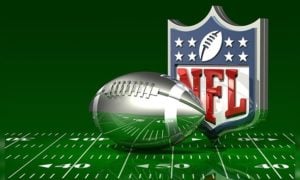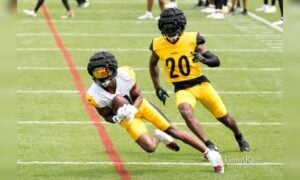Stats and rankings certainly do not tell the whole story when it comes to football, but some of them will paint a pretty good picture for you at least.
Does Pittsburgh Steelers defensive coordinator Dick LeBeau look at the stats and rankings of his defense? Sure he does, and he has admitted to such many times in the past.
In this post I intend to show some key stats and rankings that lend themselves to the makings of a solid Steelers defense. Some are of course obvious, while a few others not as much.
First off, LeBeau, and any defensive coordinator for that matter, will tell you is that stopping the run is the first order of business. If a team can\’t stop the run, it certainly puts pressure on a defense, especially the 3-4 defense that LeBeau runs in Pittsburgh.
Can teams win though without being great against the run? Certainly they can, if they have an offense that can put points on the board or a defense that tightens up when teams get inside the red zone. The New York Giants allowed 121.3 yards per game last season, which ranked them 19th in the league. In 2010 the Green Bay Packers allowed 114.9 yards per game on the ground, good for an 18th ranking. So it goes to show you that that stat is not a great measuring stick league wide when it comes to winning it all. The Steelers however have finished in the top three in all but one year in that stat every year dating back to 2004, when LeBeau returned to Pittsburgh. Last season was the only year he failed to crack a top three ranking in that stat as the Steelers finished 8th as the defense allowed 99.8 rushing yards per game. Stopping the run first is what LeBeau keys the rest of his defense around.
Now that we got stopping the run out of the way, we can focus in on the pass defense. It is well known that LeBeau plays a lot of zone and mixes in cover-2, cover-3 and cover-4 aspects in the secondary. Some will argue that zone is something that LeBeau should get away from more, but the defense has been solid for the most part dating back to 2006 when it comes to allowing explosive plays and good completion percentages. If the pass rush is getting good pressure, it is hard for offenses to sustain long drives against the zone.
Despite the Steelers pass rush not being great last year, the defense allowed just a 54.53% completion percentage, which was fifth best in the league. That was with William Gay playing outside in the base defense and inside in nickel packages. In 2010, when Bryant McFadden manned the spot opposite Ike Taylor, the defense allowed a 61.21% completion ratio, which was only good for a 15th ranking. The good quarterbacks such as Tom Brady, Drew Brees and Aaron Rodgers had their way with the Steelers defense in 2010 if you remember and a few lesser name quarterbacks posted 60% or better completion percentages as well.
The Steelers pass rush also hopefully leads to sacks, but with linebackers James Harrison and LaMarr Woodley down a good chunk of the 2011 season with injuries, the defense totaled just 35 regular season sacks, the fewest a LeBeau led defense has had since his 2004 return. That meant that they totaled a sack just once every 16.14 drop backs (pass attempts + sacks). The defense still surprisingly was able to put up a 54.53% completion rate despite the lack of great pressure last season. With Woodley and Harrison hopefully now back to full health in 2012, those sack numbers and pressure put on opposing quarterbacks should improve.
Turnovers was certainly one statistical area that the defense was deficient in last season. Their 11 interceptions in 2011 ranked them 25th in the league as they only intercepted one pass every 48.18 passing attempts. Do you think the lack of a good pass rush played a big part in that? I certainly do. LeBeau has admitted that turnovers have to be better this upcoming season and he is confident that they will be. Really, how can they not improve in that area?
Some of the less talked about stats of the Steelers defense that do not get enough credit are the explosive plays and yards after catch stats. I posted quite a bit about explosive plays last season as it relates to differential, and more importantly wins. Last season the Steelers defense allowed just 34 passing plays of 20 yards or more and that equated to only one passing explosive play per 15.59 passing attempt. Those two stats led the league last year. The defense also led the league in both of those stats in 2010 and 2008 as well and they finished 3rd in both of those stats in 2007. A team in the NFL has around an 80% win rate if they have a two or greater TOX (turnovers + explosive plays) stat differential. Explosive plays matter and they matter a lot, especially to a 2011 Steelers team that was deficient in the takeaway column.
Yards after catch is also a stat that the Steelers are normally good in. The Steelers love drafting cornerbacks that are good tacklers and not afraid to hit. That, combined with solid inside linebacker and safety play has resulted in the Steelers defense finishing in the top two in the YAC stat four out of the last six seasons. In 2009 they finished 6th and in 2006 they finished 16th. Both of those seasons the Steelers failed to make the playoffs and both of those seasons the defense ranked poorly in allowing explosive plays as well.
As good as the defense was in both of those statistical categories last season, it all came apart in the AFC Wild Card game against the Denver Broncos. The unit allowed 5 explosive plays on just 10 completions and 128 yards after the catch, 63 of which came on the final play of the season.
Like I said at the beginning of this post, stats do not tell the whole story, but sacks, completion percentage, explosive plays and yards after catch are four key stats that are always tracked heavily in addition to the obvious run stats when monitoring a LeBeau led defense.
The two stats to perhaps pay real close attention to this upcoming season is the explosive play and yards after catch numbers with both Keenan Lewis and Cortez Allen expected to see quite a bit of time now in the secondary with Gay now gone via free agency. A ranking outside of the top 5 in both of those stats will likely put even more pressure on the offense. That is something that they do not need, at least early on in the season, with a new offense being installed.
| TEAM | YEAR | RuYPG | RANK | SACKS | RANK | SACK/DB | RANK | PYDS | ATT | COMP | COMP % | RANK |
| PIT | 2006 | 88.3 | 3 | 39 | 12 | 14.56 | 13 | 3619 | 529 | 319 | 60.30% | 21 |
| PIT | 2007 | 89.9 | 3 | 36 | 14 | 15.89 | 15 | 3067 | 536 | 292 | 54.48% | 1 |
| PIT | 2008 | 80.3 | 2 | 51 | 2 | 11.45 | 2 | 2861 | 533 | 301 | 56.47% | 4 |
| PIT | 2009 | 89.9 | 3 | 47 | 2 | 12.66 | 3 | 3761 | 548 | 319 | 58.21% | 7 |
| PIT | 2010 | 62.8 | 1 | 48 | 1 | 13.35 | 6 | 3744 | 593 | 363 | 61.21% | 15 |
| PIT | 2011 | 99.8 | 8 | 35 | 18 | 16.14 | 18 | 2981 | 530 | 289 | 54.53% | 5 |
| TEAM | YEAR | INT | RANK | INT/PA | RANK | YAC/AVG | RANK | 20+ | RANK | 20+/PA | RANK | 20+/PC | RANK |
| PIT | 2006 | 20 | 7 | 26.45 | 7 | 4.85 | 16 | 44 | 19 | 12.02 | 17 | 7.25 | 17 |
| PIT | 2007 | 11 | 30 | 48.73 | 30 | 3.79 | 2 | 32 | 3 | 16.75 | 3 | 9.13 | 11 |
| PIT | 2008 | 20 | 7 | 26.65 | 5 | 4.27 | 2 | 23 | 1 | 23.17 | 1 | 13.09 | 1 |
| PIT | 2009 | 12 | 25 | 45.67 | 25 | 3.76 | 6 | 46 | 16 | 11.91 | 18 | 6.93 | 18 |
| PIT | 2010 | 21 | 6 | 28.24 | 9 | 3.88 | 1 | 35 | 1 | 16.94 | 1 | 10.37 | 1 |
| PIT | 2011 | 11 | 25 | 48.18 | 25 | 4.33 | 1 | 34 | 1 | 15.59 | 1 | 8.50 | 1 |







